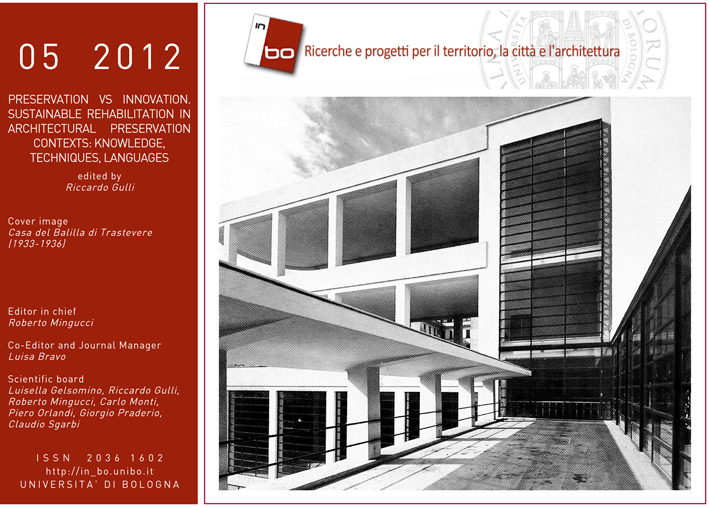Energy retrofitting design of existing building stock. The case study of social housing
DOI:
https://doi.org/10.6092/issn.2036-1602/3489Keywords:
energy and architectural retrofitting, social housing, economic and social feasibilityAbstract
Within the current discussion on the feasibility of energy retrofitting buildings’ operations, the pilot-study experience developed in the district Corticella in Bologna offers an updated review of the possible methods and techniques to be applied to reduce the energy consumption in existing buildings. In particular, the re-design of buildings, starting from the basic hypothesis of standard interventions, such as insulation and replacement of windows, has been further developed to envisage higher transformation scenarios such as the volumetric adds-on and roof-top elevations; these solutions are shown as possible means to: i) enhance the technical and economic feasibility of the retrofitting actions; ii) compensate the stiffness of existing building types; iii) promote adaptable, flexible, user-centred solutions as possible tools for communication with the human being, as “technical guides” to help the increase of his knowledge and awareness on energy-conscious behaviour.
References
Balaras C. et al. (2007), European residential buildings and empirical assessment of the Hellenic building stock, energy consumption, emissions and potential energy savings, Building and Environment, Volume 42, Issue 3, March 2007, Pages 1298–1314
Bardelli, P. G. (2010), Introduzione. In “Innovazione ed evoluzione nel progetto della residenza. Le nuove frontiere dell’industrializzazione per l’Housing in Italia”, a cura di Gulli R. e Greco A., Edicom Edizioni, Monfalcone
Bernardoni S. (2009) Progetto e costruzione nelle esperienze dell’edilizia sociale a Bologna degli anni ’60-’70. La riqualificazione delle Torri del Pilastro. Tesi di Laurea in Architettura Tecnica. Laurea in Ingegneria Edile-Architettura. Relatore Prof. Gulli R., Correlatori Guidotti A., Mochi G.. AA_2008-2009. Sessione III
Calthorpe P., 1993, The Next American Metropolis: Ecology, Community, and the American Dream, Princeton Architectural Press, Princeton
Cattani, E. (2011) Casablanca 1950-Utrecht 2011: Self-expression, adattabiltà e flessibilità per un progetto di rinnovo urbano e tipologico del distretto di Kanaleneiland (NL). Tesi di Laurea in Architettura Tecnica. Laurea in Ingegneria Edile-Architettura. Relatore: A. Ferrante; correlatori: G. Mochi, B. van Buiten, FBW architekten. AA. 2009/2010. Sessione III
Correa, C. (1989) ‘The New Landscape: Urbanization in the Third World’, Mimar Book published by Concept Media Ltd
Folke C, Hahn T, Olsson P, Norberg J, 2005, “Adaptive Governance of Social-Ecological Systems”, Annual Review of Environment and Resources, Vol. 30, 441-73
Heiskanen E, Johnson M, Robinson S, Vadovics E, Saastamoinen M, 2010, “Low-carbon communities as a context for individual behavioural change”, Energy Policy 38, pp. 7586-7595
Garreau J, 1991, Edge City: Life on the New Frontier (Doubleday, New York)
Gibelli M.C., Salzano E. (2006) No sprawl, Alinea, Firenze
Gulli, R. (2010), Sperimentazione tecnica ed innovazione architettonica nel progetto della residenza pubblica. Due Vicende del Novecento. In “Innovazione ed evoluzione nel progetto della residenza. Le nuove frontiere dell’industrializzazione per l’Housing in Italia”, a cura di Gulli R. e Greco A., Edicom Edizioni, Monfalcone
Guy S, 2006, “Designing urban knowledge: competing perspectives on energy and buildings”, Environment and Planning C: Government and Policy, volume 24, pages 645 – 659
Kohler, N. (1999) The relevance of Green Building Challenge: an observer’s perspective, Building Research and Innovation, 27 (4/5), 309-320
Nye M, Whitmarrsh L, Foxon T, 2010, “Socio-psychological perspectives on the active roles of domestic actors in transition to a lower carbon electricity economy”, Environment and Planning A 2010, volume 42, pages 697-714
PEC (2012), Piano Energetico Comunale, Comune di Bologna
Reale L. (2008), Densità, città, residenza. Tecniche di densificazione e strategie anti-sprawl. Gangemi Editore, Roma
Webler T, Seth P Tuler, 2010, “Getting the engineering right is not always enough: Researching the human dimensions of the new energy technologies”, Energy Policy 38 2690–2691
Downloads
Published
How to Cite
Issue
Section
License
Copyright (c) 2012 Annarita Ferrante, Elena Cattani, Nicola Bartolini, Giovanni Semprini
Copyrights and publishing rights of all the texts on this journal belong to the respective authors without restrictions.
This journal is licensed under a Creative Commons Attribution-NonCommercial 4.0 International License (full legal code).
See also our Open Access Policy.
Metadata
All the metadata of the published material is released in the public domain and may be used by anyone free of charge. This includes references.
Metadata — including references — may be re-used in any medium without prior permission for both not-for-profit and for-profit purposes. We kindly ask users to provide a link to the original metadata record.







